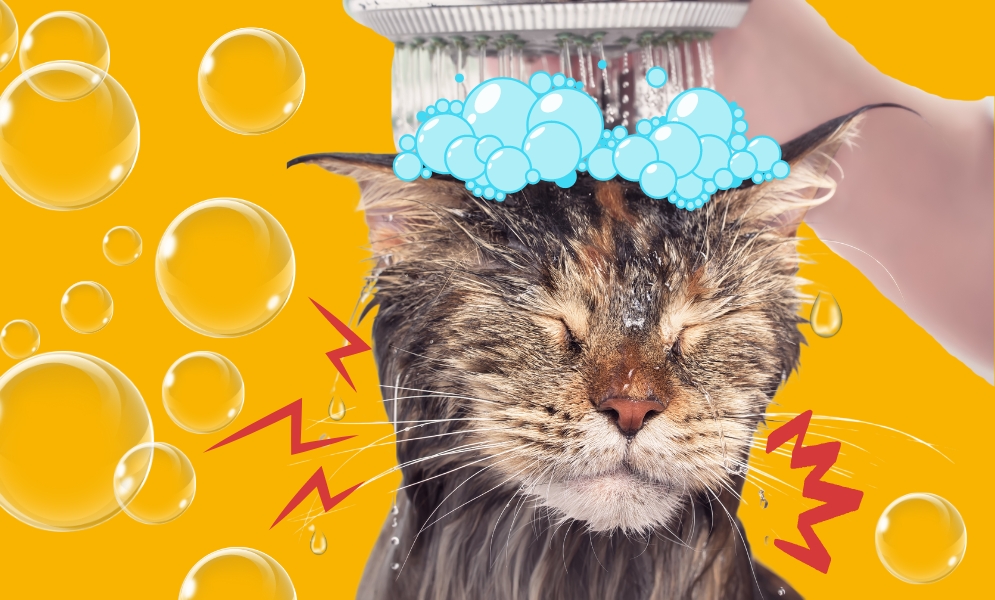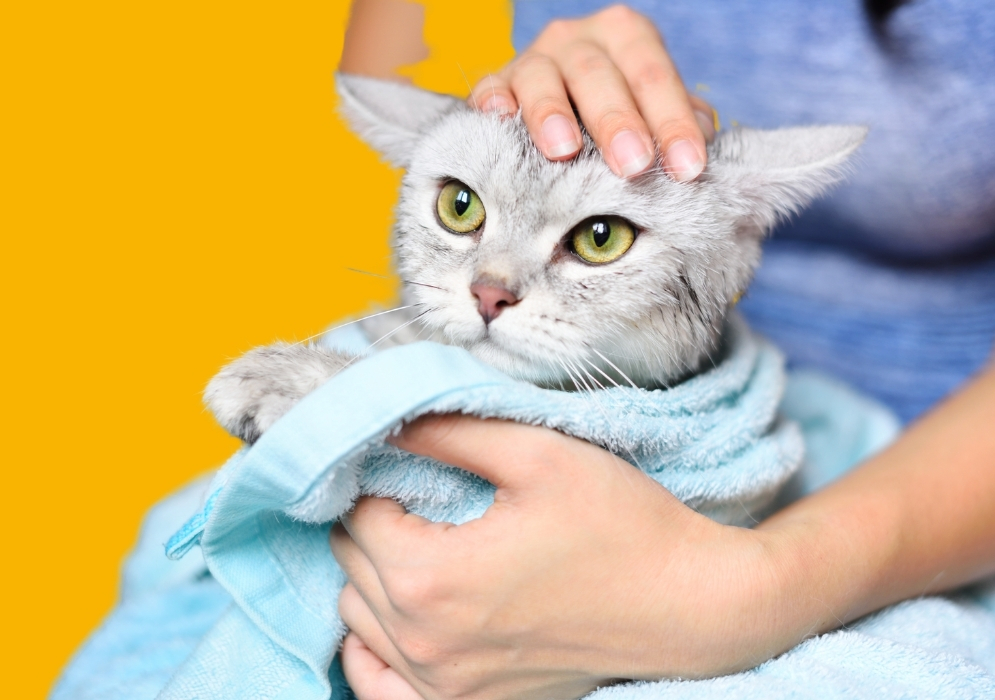How To Bathe a Cat – The Ultimate Tips and Tricks


So you got a cat – a fluffy, purring, independent little creature who is pretty good at taking care of themselves. Now, you are probably very happy about it because it means you don’t have to spend a lot of time bathing and grooming your new pet, which can be taxing.
Well, you are right about that because cats, among many things, are also good at grooming themselves and staying clean. However, there are times when a bath is unavoidable. Maybe their coat is matted, they rolled in something gross, or they have a skin condition.
Whatever the reason, bath time is probably not your cat’s favorite activity since most domestic cats dont like water as a rule. But fear not! In this article, we will explore some tips and tricks on how to bathe a cat. It will help make bath time less stressful for both of you. Let’s dive in.
The Importance of Regular Grooming for Cats
While bathing is essential to your cat’s grooming routine, it’s crucial to understand that it’s just one aspect of the overall grooming routine. Regular grooming helps keep your cat looking and feeling their best and also helps them stay physically healthy.
Grooming helps remove loose hair, preventing hairballs and reducing the risk of intestinal blockages. It also allows you to check for any abnormalities, such as lumps, bumps, or skin irritations, which could indicate underlying health issues in cats
Also, grooming sessions provide a chance to bond and strengthen the relationship between you and your cat.
Including regular grooming into your cat’s routine will help maintain their coat’s condition, promote healthy skin, and prevent potential health problems. Remember, grooming is not just about appearances – it’s essential to overall cat care and well-being.
How Often Should You Bathe Your Cat?

Now that you know how important grooming is for cats, let’s learn more about how to give a cat a bath and how often you should do it. The frequency of bathing your cat depends on several factors, including their breed, coat type, and lifestyle.
Generally, most cats with short hair and indoor lifestyles can be bathed every 4-6 weeks, while outdoor or long-haired cats may require more frequent bathing, possibly every 2-4 weeks.
However, it’s essential to keep in mind that over-bathing can strip your cat’s coat of its natural oils, leading to dry skin and other issues. If you notice your cat’s coat becoming dull or their skin becoming dry or irritated, you may need to reduce the frequency of bathing.
Additionally, how often to bathe a cat also depends on the following situations:
- After exposure to something particularly messy or smelly
- If your cat has a medical condition that requires regular bathing
- If your cat has a flea infestation
It’s always best to consult with your veterinarian or a professional groomer to determine the ideal bathing schedulemeet your cat’s specific needs.
How To Prepare for a Cat Bath and Essential Supplies
The important aspect of learning to bathe a cat is knowing what essential supplies you need and how to prepare for it. It will make the process easier. Here’s what you’ll need:
Supplies:
- A large, non-slip bathtub or sink (or a dedicated pet bathing station)
- A handheld shower head or a pitcher for rinsing
- A non-slip mat or towel to line the bathing area
- A gentle, cat-safe shampoo (avoid human shampoos, as they can be too harsh)
- A soft-bristled brush or comb
- Plenty of towels for drying
- Treats or catnip (for positive reinforcement)
- A quiet, stress-free environment
Tips for preparation:
- Gather all your supplies beforehand and have them within reach.
- Ensure the bathing area is warm and draft-free to prevent your cat from getting chilled.
- Trim your cat’s nails before the bath to avoid accidental scratches.
- Consider using a pheromone diffuser or calming supplement to help reduce your cat’s stress levels.
- Have a towel or mat ready for your cat to stand on after the bath to prevent slipping.
- Enlist the help of a second person, if possible, to assist with restraining and rinsing your cat.
By preparing the bathing area and having all the necessary supplies , you can ensure a smoother and less stressful experience for you and your feline friend.
Step-by-step Guide on How to Safely Bathe a Cat

Now that you’ve gathered all the essential supplies and prepared the bathing area, it’s time to tackle the task at hand (even if you are not looking forward to it much) – bathing your cat.
Follow these step-by-step instructions for a safe and successful bathing experience:
Acclimate Your Cat
Before starting the bath, allow your cat to explore the bathing area and become familiar with the surroundings. This can help reduce their stress levels.
Brush Your Cat
Gently brush your cat’s coat to remove loose hair or mats before the bath. This will make bathing easier and prevent excess hair from clogging the drain.
Fill the Tub or Sink
Fill the bathing area with a few inches of lukewarm water, ensuring it’s not too hot or too cold for your cat’s comfort.
Introduce Your Cat to the Water
Slowly and gently lower your cat into the water, allowing them to get accustomed to the sensation. Speak in a calm, reassuring tone to help them feel at ease.
Wet Their Coat
Using a pitcher or handheld shower head, thoroughly wet your cat’s coat, being careful to avoid getting water in their ears or eyes.
Apply Shampoo
Massage a small amount of cat-safe shampoo into your cat’s coat, working from the neck down and avoiding their face and ears.
Rinse Thoroughly
Rinse your cat’s coat completely, ensuring all traces of shampoo are removed. Residual shampoo can cause skin irritation and dryness.
Dry and Groom
Wrap your cat in a towel and gently pat them dry, being careful not to rub too vigorously. Once partially dry, brush or comb remove any remaining loose hair or tangles.
Reward and Praise
Offer your cat treats, catnip, or their favorite toys to reward their good behavior during the bath. Praise them and provide plenty of positive reinforcement.
If you want to know how to give a cat a flea bath, then you can follow the same process above. You just must use a medicinal flea shampoo (preferably one recommended by your vet) instead of regular shampoo. Also, follow the instructions on the bottle carefully, or if you have any questions, ask your vet.
Remember, patience and a gentle approach are key when bathing your cat. If your cat becomes overly stressed or agitated, it’s best to stop and try again another day.
Tips and Tricks for Making Bath Time Less Stressful for Your Cat

While bathing your cat can be necessary , it’s often met with resistance and stress from our feline friends. However, there are several tips and tricks you can apply if you want to know how to bathe a cat in a less stressful manner:
Start Early
Introduce your cat to the bathing routine at a young age, as kittens are generally more adaptable and less fearful of new experiences.
Use Positive Reinforcement
Offer your cat treats, praise, and their favorite toys during and after the bath to create positive associations with the experience.
Stay Calm
Cats can sense your emotions, so staying calm and patient is essential throughout the bathing process. Avoid raising your voice or becoming frustrated, as this can heighten your cat’s stress levels.
Consider a Calming Aid
Using products like calming supplements and pheromone diffusers for cats or even playing soothing music can help reduce your cat’s anxiety during bath time.
Go Slowly
Take the bathing process step-by-step, allowing your cat time to adjust and become comfortable with each new sensation.
Use a Secure Hold
Gently but firmly hold your cat securely , such as wrapping them in a towel or using a mesh bathing bag, to prevent them from escaping or becoming too agitated.
Provide a Safe Space
After the bath, allow your cat to retreat to a quiet, familiar space where they can groom and recover from the experience.
Remember, every cat is different, and the tips mentioned here regarding how to bathe a cat are general suggestions. If you have a docile cat, you will probably find the bathing process easy.
But if you have a cat with a wild temperament, it may take some trial and error to find the best techniques for your feline friend. All you need is patience, positive reinforcement, and a gentle approach to make bath time less stressful and a more enjoyable experience for both of you.
A Clean Cat Is A Happy Cat
Remember, regular grooming and bathing are essential for your cat’s overall well-being. It will also help to prevent skin issues, matting, and other health problems. But if you are a first-time cat parent, it may seem like a daunting task.
But with the right approach and by following the tips and tricks on how to bathe a cat, rest assured that it will be a manageable and even enjoyable experience for both you and your cat.









Leave A Comment